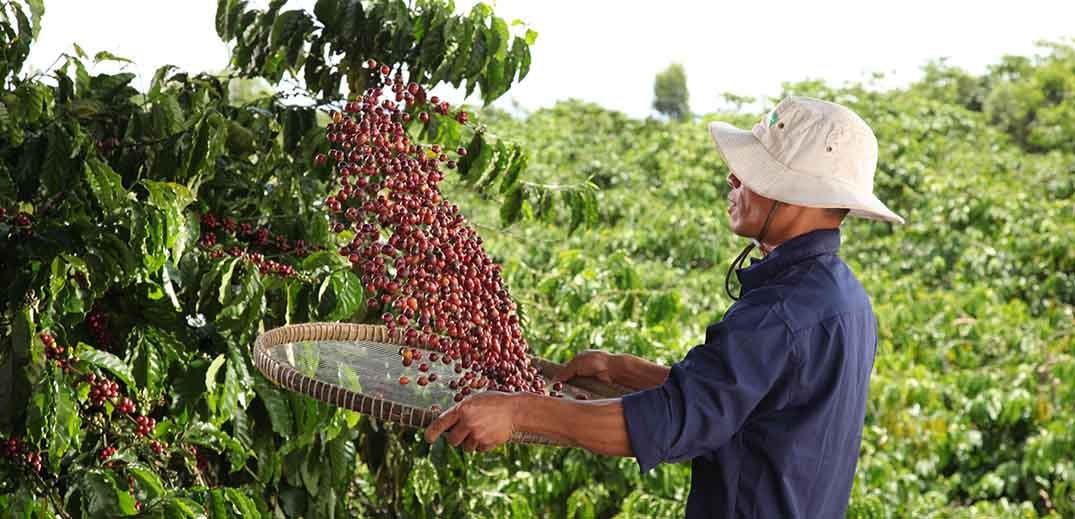- Strona główna
- >
- Coffee stories
- >
- Podróż ziarna: od farmy do filiżanki
Podróż ziarna: od farmy do filiżanki
Każdy łyk kawy specialty opowiada historię, która rozciąga się na kontynenty i kultury, od bujnych krajobrazów egzotycznych farm po filiżankę kawy w Twoim poranku. Ta podróż ziaren kawy to nie tylko kwestia odległości, ale także dokładnych procesów i zrównoważonych praktyk, które wydobywają unikalne smaki, które uwielbiamy. Pozwól, że przyjrzymy się tej fascynującej podróży, podkreślając staranność, która sprawia, że kawa specialty jest naprawdę wyjątkowa.
Pochodzenie: Zrównoważone farmy
Historia zaczyna się w zielonych wzgórzach regionów takich jak Etiopia, Kolumbia i Brazylia, gdzie głównie uprawiane są ziarna Arabiki, znane z gładkich, złożonych profili smakowych. Te ziarna rozwijają się na dużych wysokościach i wymagają precyzyjnego klimatu, aby mogły rosnąć. Rolnicy, którzy dbają o zrównoważone i ekologiczne praktyki, pielęgnują te rośliny kawowe, zapewniając, że każdy etap, od przygotowania gleby po sadzenie, wspiera zdrowie środowiska i produkuje najwyższej jakości ziarna. To podejście nie tylko pomaga utrzymać równowagę ekologiczną, ale także zapewnia, że farmy będą mogły produkować wysokiej jakości kawę przez wiele lat.

Zbiory: Proces zbierania
Ziarna kawy zaczynają się jako owoce na roślinach kawowych, a ich zbiór często odbywa się ręcznie, zwłaszcza w górzystych regionach. Ten czasochłonny proces zapewnia, że zbierane są tylko dojrzałe owoce, w odpowiednim momencie, co jest kluczowe dla jakości kawy specialty. Czas zbiorów jest istotny; zrywanie owoców za wcześnie lub za późno może znacznie wpłynąć na smak kawy.
Przetwarzanie: Droga do smaku
Po zbiorze przetwarzanie owoców kawowych ma kluczowe znaczenie i znacząco wpływa na ostateczny profil smakowy kawy. Istnieje kilka metod przetwarzania:
Proces suchy (naturalny): Najstarsza metoda przetwarzania kawy, w której całe owoce kawowe suszone są na słońcu. Ta metoda często nadaje kawie słodszy, owocowy smak, ponieważ ziarno ma więcej kontaktu z owocem podczas suszenia.
Proces mokry (myty): W tej metodzie owoc pokrywający ziarna jest usuwany przed ich wysuszeniem. Po usunięciu ziarna są umieszczane w zbiornikach fermentacyjnych napełnionych wodą. Ten proces zwykle daje kawie czystszy, bardziej wyrazisty kwasowy smak.
Fermentacja beztlenowa: Jest to wariant procesu mycia, w którym kawa jest fermentowana w zamkniętym, pozbawionym tlenu środowisku. Przetwarzanie beztlenowe pozwala na precyzyjne kontrolowanie zmiennych fermentacyjnych, tworząc unikalne, złożone profile smakowe kawy.
Palenie: Tworzenie smaku
Po przetworzeniu ziarna są wysyłane na całym świecie do palarni, które przekształcają je z zielonych, niepozornych nasion w bogate, aromatyczne ziarna kawy. Palenie to miejsce, gdzie dzieje się magia, a prawdziwy smak kawy zostaje opracowany. Proces palenia wymaga delikatnej równowagi temperatury i czasu, a różne style palenia mogą znacząco zmienić smak końcowego produktu. Palacze muszą zrozumieć charakterystyki każdego typu ziarna i dostosować techniki, aby wydobyć najlepsze smaki.
Parzenie: Ostatni krok
Ostatni etap podróży to parzenie, podczas którego prażone ziarna kawy są mielone, a następnie parzone. To tutaj cała ciężka praca zostaje uwieńczona sukcesem. Metoda parzenia, czy to espresso, french press, pour-over, czy inne, także odgrywa kluczową rolę w kształtowaniu końcowego smaku kawy.
Od zrównoważonych praktyk rolniczych na egzotycznym wzgórzu po precyzyjną sztukę parzenia, każdy etap podróży ziarna kawy jest napędzany pasją i oddaniem. Każda filiżanka kawy specialty oferuje nie tylko zastrzyk kofeiny, ale także smak bogatych historii i tradycji uprawy i produkcji kawy. Więc następnym razem, gdy wypijesz swoją starannie przygotowaną kawę, pamiętaj o podróży, jaką przeszła, aby trafić do Twojej filiżanki – prawdziwej globalnej wyprawie.
